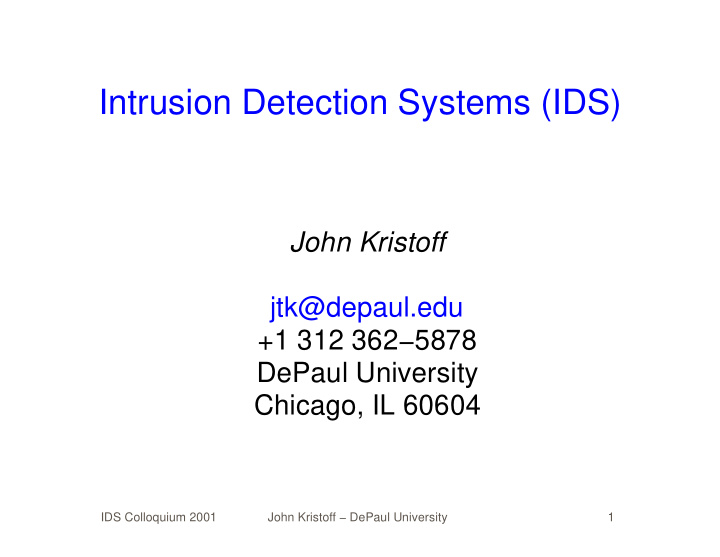



Intrusion Detection Systems (IDS) John Kristoff jtk@depaul.edu +1 312 362−5878 DePaul University Chicago, IL 60604 IDS Colloquium 2001 John Kristoff − DePaul University 1
� � � � Why IDS? Interesting, but immature technology Provides lots of data/information Generally doesn’t interfere with communications Anything that improves security... IDS Colloquium 2001 John Kristoff − DePaul University 2
� � � � ✁ ✁ � ✁ What is IDS? Ideally, immediately identifies successful attacks Should have a immediate notification system Out−of−band from the attack if possible Probably can also monitor attack attempts too Might have attack diagnosis, recommendation and/or automated attack mitigation response Lofty goals: 0% false positive rate 0% false negative rate IDS Colloquium 2001 John Kristoff − DePaul University 3
✁ � � � ✁ ✁ ✁ � Privacy issues Does an IDS violate privacy? Are packet headers (protocols) private? Is identification (an address) private? Are packet contents private (payload)? Are communications (flows/sessions) private? Where is the IDS? Who manages the IDS? How is the IDS data handled and managed? IDS Colloquium 2001 John Kristoff − DePaul University 4
� � � � � � � Storage, mining and presentation IDSs can collect LOTS of information What is useful data? What are you looking for? Data correlation within/outside of the IDS? What does the admin see? Where and for how long do you keep data? How do you secure access to IDS data? IDS Colloquium 2001 John Kristoff − DePaul University 5
✁ � � � ✁ ✁ � � Host IDS An integral part of an end−system System log monitor Kernel level packet monitor Application specific A very good place to put security Distributed management issues Not all end systems will support an IDS Will be as useful as the end user is cluefull IDS Colloquium 2001 John Kristoff − DePaul University 6
✁ � � � � ✁ � Network IDS An add−on to the communications system Generally passive and invisible to the ends May see things a host IDS cannot easily see Fragmentation, other host attacks (correlation) May not understand network traffic Unknown protocols/applications, encryption May miss things that don’t cross its boundary IDS Colloquium 2001 John Kristoff − DePaul University 7
� � � � � � ✁ Anomaly detection A form of artificial intelligence Learn what is normal for a network/system If an event is not normal, generate alert May catch new attacks not seen before For a simple, but effective example see: Detecting Backdoors , Y. Zhang and V. Paxson, 9 th USENIX Security Symposium An area of active research IDS Colloquium 2001 John Kristoff − DePaul University 8
� � � � � � Signature matching Know what an attack looks like and look for it Very easy to implement Low false positive rate Most current IDSs are of this type Easy to fool Signatures must be added/updated regularly IDS Colloquium 2001 John Kristoff − DePaul University 9
� � � ✁ � � � Honeypots A system that welcomes attacks Unbeknownst to the attacker generally The system is very closely monitored Can be used to test new technology/systems Generally educational in nature Helpful as trend monitor for that system type Be careful honeypot doesn’t become liability IDS Colloquium 2001 John Kristoff − DePaul University 10
✁ � � � ✁ � � � Possible IDS failure modes Fragmentation, state and high−speeds Requires lots of CPU, memory and bandwidth Inability to decode message/transaction t^Hrr^Hm56^H^H //^H −u^Hrf Background noise Tunnelling/encryption IDS path evasion Stupid user tricks IDS Colloquium 2001 John Kristoff − DePaul University 11
� ✁ � � ✁ ✁ � ✁ The poor man’s Network IDS Setup a router subnet and unix host Block all outgoing/incoming packets access−list 100 deny ip any any log Log packets (filter matches) with syslog Use perl/grep/uniq/... to build simple reports Total violations: 468 Top source host: badguy.org Top dest. TCP port: 21 (ftp) IDS Colloquium 2001 John Kristoff − DePaul University 12
✁ � � � � ✁ � The poor man’s host IDS Use snort (http://www.snort.org) or... Turn on all logging and do log reporting Install fake service and monitor tcp_wrappers, back officer friendly Use diff (or equivalent), monitor file changes Keep copies of data/configs elsewhere Use Tripwire or equivalent IDS Colloquium 2001 John Kristoff − DePaul University 13
� � � � � � � References Network Intrusion Detection, An Analyst’s Handbook , by Stephen Northcutt http://www.cerias.purdue.edu http://www.usenix.org ids−request@uow.edu.au in body put "help" http://www.research.att.com/~smb/ http://www.cert.org http://networks.depaul.edu IDS Colloquium 2001 John Kristoff − DePaul University 14
Recommend
More recommend